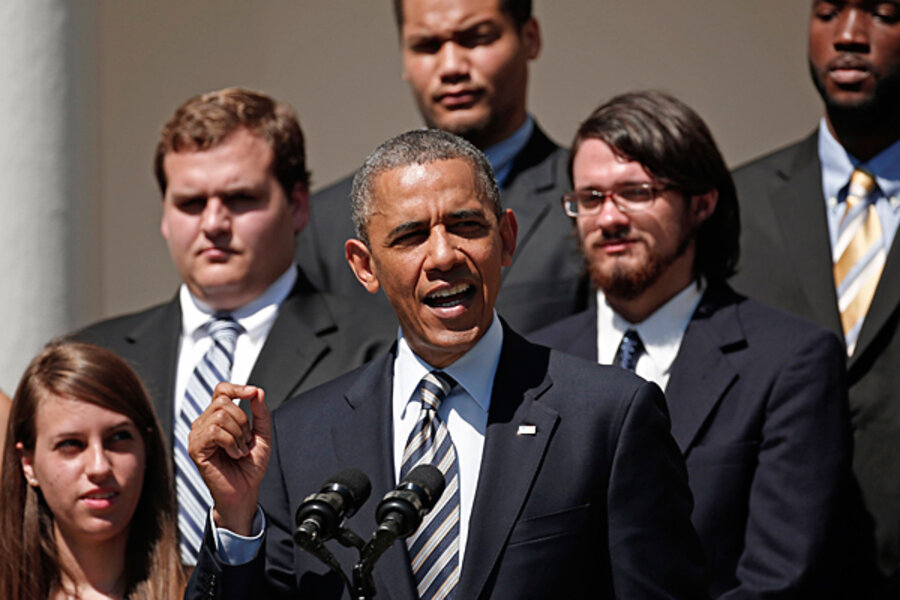Student loans 101: What's really at stake as Washington squabbles
Loading...
As July 1 approaches, there’s a lot of squabbling in Washington over student loan interest rates and the need to prevent them from doubling.
Here’s a primer on what’s really at stake in the debate.
Which types of loans would actually have their interest rates double on July 1 if no new law passes in Washington?
They’re called subsidized Stafford loans, and about 7 million low-income and middle-income students qualify for them each year. The current interest rate is 3.4 percent, but the deal that created that rate will expire July 1 and set the rate at 6.8 percent.
These loans represent about 26 percent of the total federal student loan volume. (Most families also rely on unsubsidized Stafford loans and/or PLUS loans, which already bear interest rates of 6.8 percent and 7.9 percent, respectively.)
What’s in common among the various long-term proposals to change how interest rates are set?
Creating market-based rates for both Stafford and PLUS loans is the key goal of a bill the House recently passed by Rep. John Kline (R) of Minnesota and of proposals by President Obama, Sen. Jack Reed (D) of Rhode Island, and Sen. Tom Coburn (R) of Oklahoma. They would tie the loans to the 10-year Treasury note, except for Senator Reed’s, which would tie them to the 91-day Treasury note.
What are the key differences?
The proposals tack different percentage points onto the market-based rates to pay for the administration of the loans.
Mr. Obama’s and Sen. Coburn’s proposals vary the rates year to year, but when the student takes out that loan, the rate they get is fixed for the life of the loan. These two proposals also do not include a cap on interest rates. But options for capping the portion of income that has to be repaid each month would be expanded.
The House bill and Sen. Reed’s proposal have rates that vary year to year with the market over the life of the loan. The House would cap all Stafford loans at 8.5 percent and PLUS loans at 10.5 percent. Reed’s would cap subsidized Stafford loans at 6.8 percent and unsubsidized Staffords and PLUS at 8.25 percent.
Why are Obama and House Republicans battling when their proposals actually have quite a bit in common?
Obama is using the issue to highlight the need to invest in educating low-income and middle-income Americans for the jobs of the future.
The House bill “fails to lock in low rates for students next year. That’s not smart. It eliminates safeguards for lower-income families. That’s not fair,” said Obama, flanked by indebted college students, at a White House event Friday morning.
Because market rates are currently low, Obama’s proposal would lower rates for many students in the coming school year. For instance, a student who takes out a subsidized Stafford loan at a rate of a projected 2.9 percent would save more than $4,300 over the life of the loan if borrowing the average of about $27,000.
According to a White House fact sheet, because the House Republican bill combines subsidized and unsubsidized loans at a higher rate, that same student would pay $200 more over the life of the loan under that bill than if Congress did nothing at all by July 1. The White House accuses the Republican authors of their plan of saving money for deficit reduction on the backs of low-income students.
“Last week, the House passed legislation that would prevent student loan rates from doubling and permanently take politics out of the issue,” House Speaker John Boehner (R) of Ohio responded in a statement Friday morning. “The differences between the House plan and the president’s are small, and there’s no reason they cannot be overcome quickly. But today, rather than working to resolve the issue, the president resorted to a campaign stunt to try to score political points. If the president is truly unhappy with inaction, the only place to look is the Democratic-run Senate, which has taken no action to prevent rates from doubling.”
College-access advocates share President Obama’s concern about investing in low-income students, but one element of the House plan they prefer is the caps. If market-based rates spike in coming years, there is no cap in Obama’s plan to prevent students from taking on significantly higher debt loads than they currently carry.
What other proposals have emerged on Capitol Hill?
Several short-term fix ideas have emerged, which some Senate Democrats favor so that they’ll have more time to consider a long-term solution to the student loan interest rate situation in the context of other higher education affordability issues. For instance, Sen. Tom Harkin (D) of Iowa and others have proposed a bill that would fix the rates as they currently are for two years. The Senate is scheduled to vote on that next week.
Sen. Elizabeth Warren (D) of Massachusetts has proposed allowing the Federal Reserve to offer students a 0.75 percent interest rate for at least the coming year, arguing that students should get the same kind of breaks that banks do when they need to borrow from the government.
A one-year fix proved popular last year. It passed in Congress with bipartisan support, but made another battle this year utterly predictable.
See you here again next year?








